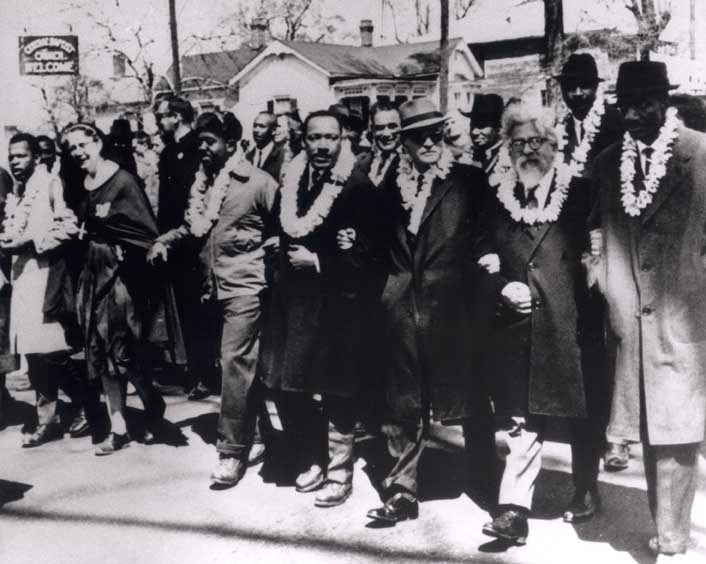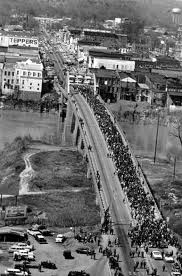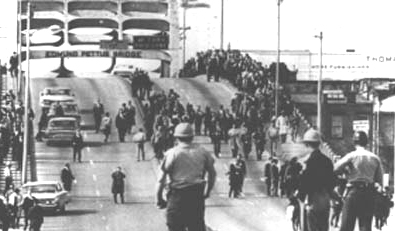Main Page > 2010 Civil Whites Tour >
Rising on that cool February morning, Mike and
Bone's head spun from the one too many Pabst Blue Ribbon's from the night
before. Grabbing two cups of coffee, they went to the first stop of the Tour at one of the saddest pivotal moments
of the Civil Rights Movement, the Assignation of the Reverend Martin Luther King
at the Lorraine Motel.
Civil Right Tour Stop 1: The Lorraine Motel
Martin Luther King had traveled to Memphis in
April 1968 to support of striking African American sanitation workers. The workers had
staged a walkout on February 11, 1968, to protest unequal wages and working
conditions imposed by then-mayor Henry Loeb. At the time, Memphis paid black
workers significantly lower wages than whites. In addition, unlike white people,
black workers received no pay if they stayed home during bad weather;
consequently, most black people were compelled to work even in driving rain and
snow storms.
On April Thursday 4th, Reverend King was booked in room 306 at the Lorraine Motel in Memphis, owned by businessman Walter Bailey (and named after his wife). King's close friend and colleague Reverend Ralph David Abernathy, who was King's roommate in the motel room the day of the assassination, told the House Select Committee on Assassinations that King and his entourage stayed in room 306 at the Lorraine Motel so often that it was known as the "King-Abernathy Suite, which is pictured above Mike and Bone noted with the Remembrance Wreath.
It was
6:00 in the evening when he
spoke his last words to musician Ben Branch, who was scheduled to perform
that night at an event King was going to attend: "Ben, make sure you play 'Take
My Hand, Precious Lord' in the meeting tonight. Play it real pretty."
Shortly after the shot was fired, witnesses saw James Earl Ray fleeing from a rooming house across the street from the Lorraine Motel where he was renting a room. A package was dumped close to the site that included a rifle and binoculars with Ray's fingerprints on them. The rifle had been purchased by Ray under an alias six days before. A worldwide manhunt was triggered that culminated in the arrest of Ray at London Heathrow Airport two months later.
Abernathy heard the shot from inside the motel room and ran to the balcony to find King on the floor. King was bleeding profusely from the wound in his cheek. His Southern Christian Leadership Conference (SCLC) colleague Andrew Young believed he was dead, though King still had a pulse.
King was rushed to St. Joseph's Hospital, where doctors opened his chest and performed Cardiopulmonary resuscitation. He never regained consciousness and was pronounced dead at 7:05 p.m. According to Taylor Branch, King's autopsy revealed that though he was only 39 years old, he had the heart of a 60-year-old man which Branch attributed to the stress of 13 years in the civil rights movement.
While Mike and Bone walked around the Lorraine which is now the National Civil Rights Museum. Unfortunately the Museum was closed that day for a special event ! Bummed, the Boys decided that they would make sure that they would make it back to tour the Museum on a subsequent visit to Memphis.
With that Boys headed out of town through the very skanky, poverty-stricken southern part of Memphis to the flat, flat lands of northern Mississippi as the Boys bee-lined to Tuscaloosa for lunch and a walk in Selma!
Grabbin' a Bar-be-Que snack at Steve's !
So much of the Bar-b-que down south is simply roadside pit's serving great, pit-smoked meat. Halfway to Tuscaloosa and Mike and Bone saw such a stand and hadda try it. Splitting a half a rack the Boys enjoyed the sauce, but the meat was just OK, However it didn't matter! They tried it and enjoyed the experience, now with the appetizer down, on the to main course, Dreamland !
Doin' more bones at Dreamland !!
Half-way to Selma, the Boys stopped into Tuscaloosa for the "main course" at the original Dreamland! 1958 was a big year for Tuscaloosa. Not only was it the first year that Paul “Bear” Bryant starting coaching at Alabama, it was also the year that John “Big Daddy” Bishop opened his first Dreamland Café. Big Daddy was a brick mason for many years and he longed for another way to support his family. He had narrowed it down to opening either a mortuary or a restaurant and he got down on his knees and prayed for guidance. Legend has it that God told him in a dream that night to build a café on the land next to his home and Big Daddy made that dream a reality.
The original Dreamland Café is located
about two miles from the intersection of Hwy 82 and Interstate 59 just south of
Tuscaloosa in an area known as Jerusalem Heights. In the beginning, it wasn’t
just ribs and white bread. Big Daddy and his wife, Miss Lilly, served many
things from sandwiches to postage stamps. The customers always kept coming back
for the warmth they felt every time they passed through the door and Big Daddy’s
ribs and secret recipe bar-b-que sauce.
After lunch the Boys headed on down in the warm February afternoon to the next stop on the Civil Whites Tour, Selma Alabama!
Civil Right Tour Stop 2: Bridging the Past in Downtown Selma
Mike and Bone chose Selma as a Tour Stop because it was the start of the Selma to Montgomery Voting Marches in 1965. It took three attempts through extreme violence and official racism for the march finally to occur. All three marches were attempts to walk for 54 miles along the highway from Selma to the Alabama state capitol of Montgomery. The first march, initiated and directed by the Southern Christian Leadership Conference's Director of Direct Action, James Bevel, was strategized as a counter-measure to relieve the trauma and escalating anger caused by the killing of Voting Rights activist Jimmie Lee Jackson during a nighttime march in Marion, Alabama.
The Original Marchers

The voting rights movement in Selma was launched by local African-Americans who formed the Dallas County Voters League (DCVL). In 1963, the DCVL and organizers from the Student Nonviolent Coordinating Committee (SNCC) began voter-registration work. When white resistance to black voter registration proved intractable, the DCVL requested the assistance of Martin Luther King, Jr. and SCLC, who finally brought many prominent civil rights and civic leaders to support the Selma Voting Rights Movement in January, 1965.
The first march took place on March 7, 1965, or "Bloody Sunday" when 600 marchers, protesting the death of Jackson and the ongoing exclusion from the electoral process, were attacked by state and local police with billy clubs and tear gas. The scenes of the savage beatings where caught on camera and TV at the time. Outraged the Marchers tried again,


The second march took place March 9; police and marchers stood off against one another, but when the troopers stepped aside to let them pass, Dr. Martin Luther King led the marchers back to the church to avoid the trouble that had been rumored outside of the City Limits.
The third march started March 16. Protected by 2,000 soldiers of the U.S. Army, 1,900 members of the Alabama National Guard under Federal command, and many FBI agents and Federal Marshals, the marchers averaged 10 miles (16 km) a day along U.S. Route 80, known in Alabama as the "Jefferson Davis Highway". The marchers arrived in Montgomery on March 24 and at the Alabama State Capitol on March 25. All this resulted in LBJ signing the Voting Rights Act of 1965. Mike and Bone weren't gonna walk it fer sure, but they were going to drive it after they marched in solidarity over the muddy Alabama River !
Two VERY Civil Whites Marchers on the Edmund Pettis Bridge
It was a weird scene. 3:00 on a Friday afternoon and Selma was a ghost town. Mike and Bone walked over the Bridge looking at the River, the Town, and the way people looked and acted and determined sadly that not much had changed since 1965. On the other side at the River at the foot of the Edmund Pettus Bridge, and the scene of “Bloody Sunday,” the Boys discovered the National Voting Rights Museum & Institute. Walking in a very pleasant African-American Woman introduced herself to the Boys and offered (gratis) to give them a Tour. As they went through the exhibits it was apparent that not only was she very attached to the Museum, but she been a part of all three marches ! Apparently as a young girl of 14, she had tried on Bloody Sunday, too cross the Bridge with the other marches. When Bone asked her what it was like now in Selma, she unfortunately confirmed the suspicion that not much had changed in the White Community. With that somber note Mike and Bone bid adieu to their new Civil Rights colleague and started the boogie down the road on the Historic Selma to Montgomery Trail.
On the Trial to Montgomery !!!
The Selma to Montgomery National Historic Trail follows Route 80 with historical markers on events that took place during the march such as the brutal killing of a white Civil Rights worker, Viola Liuzzo of Detroit, who was shot while driving marchers home to Selma from Montgomery. She died after being taken to a local Hospital. The Local Cops and the Ku Klux Klan didn't really care if you were a young african-american male, or middle-aged white woman. They were going to use violence to prevent people from exercising their rights. With all the sobering exhibits and stories of injustice,,,, Mike and Bone needed a Beer !!!!
Toasting Robert Montgomery in a Montgomery Brew Pub
Montgomery Alabama is named after Richard Montgomery (December 2, 1738 – December 31, 1775) who was an Irish-born soldier who first served in the British Army. He later became a Major General in the Continental Army during the American Revolutionary War and he is most famous for leading the failed 1775 invasion of Canada. Montgomery (the City!) next failed as attempting to be a Capital of a country, or the first capital of the Confederate States of America.
It next failed the Country in the Montgomery Bus Boycott, which was a seminal event in the U.S. civil rights movement. It was a political and social protest campaign against the policy of racial segregation on the public transit system of Montgomery, Alabama. The campaign lasted from December 1, 1955 when Rosa Parks, an African American woman, was arrested for refusing to surrender her seat to a white person.
Finally it failed Mike and Bone by having a Trendy Bar with unfriendly people to dicker with. The Boys hit a fashionable Pub in the Downtown district to nosh on appetizers (too much bar-b-que for a full meal!) and drink some micro-brews. Sadly, the excesses of the prior evening and the long drive caught up to the Boys who retired uncharacteristically at Midnight. All-in-all, a lot of history that day !